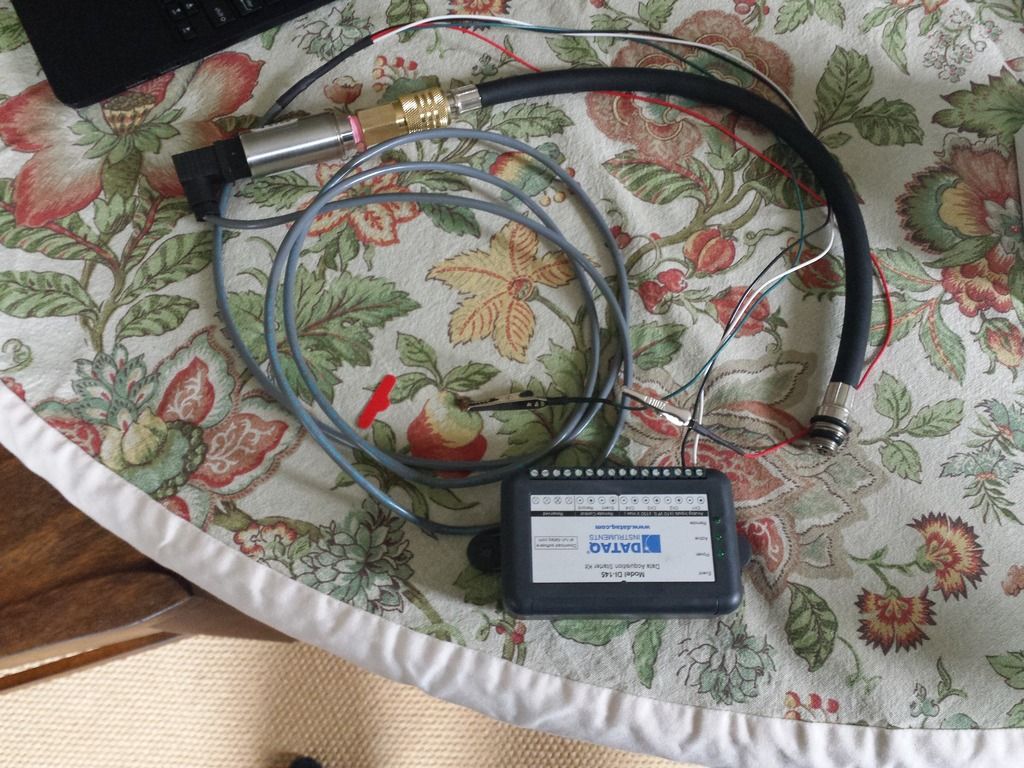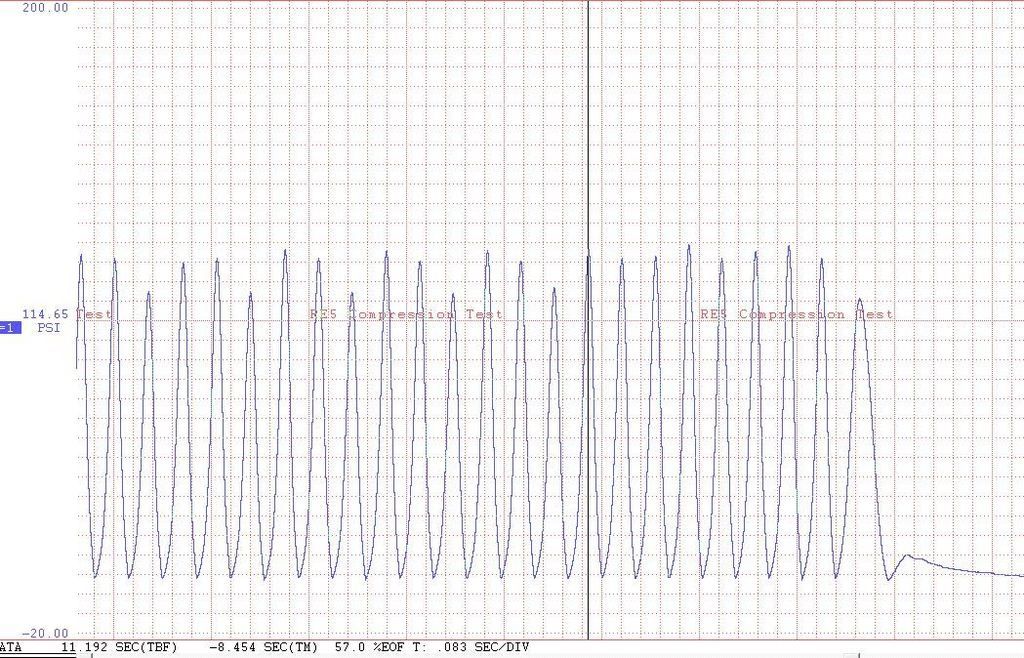|
|
Post by rpr851r on Sept 27, 2015 15:11:27 GMT -5
Hello All, I am looking for some help in deciphering my compression test. Of course if I was using the OEM compression tester there wouldn't be much to discuss but I went off and put together a tester of my own. I got the idea from another rotary site and gave it a go and now I have data to look at and would like a sanity check. My tester consists of an Omega 0-200 psi pressure transducer ($40 from ebay with calibration certificate), a DATAQ data acquisition module ($39 shipped), and a hose from my conventional compression tester.  The hose leading from the pressure transducer to the proper unit has a Schrader valve that can be removed. The first test I did was with the Schrader valve in the hose and the pressure topped out at approximately 130 psi.  The last tests I did was with the Schrader valve removed. At the beginning of the test the highest peak in that test was approximately 117 psi and the lower peaks were around 100 psi.  After approximately 6 additional seconds of cranking the peaks were all around 115 psi.  All tests were done on a cold engine with a fully charged battery and no carb on the bike. What's the general consensus of the results of the compression tests? To me it seems like a proper unit worth working with? What do you make of the ability of the proper unit to pump up to 130 psi but not being able to get above 115 psi with the Schrader valve removed? Is the difference due to the volume of the hose and unfilled volume of the spark plug hole? Anyone know what the minimum volume of the combustion chamber is under full squish so I can try and calculate a correction factor for additional volume of my compression testing rig? Regards, Rich |
|
|
|
Post by toystoretom on Sept 27, 2015 21:29:56 GMT -5
I think this unit is OK. As you guessed, you want to remove the Schrader valve, if you leave it in, the test is meaningless as you are just pumping more air and your hose is just storing the pressure, so to speak. Have you squirted any oil in the spark plug hole? That may loosen up the apex seals and improve the seal between the seals and the rotor housing. Has this motor run recently? They like to run and that will help seat the seals.
On your first test you have high low low peaks which may mean that you have one apex seal that is not so happy, but you still have compression. In your second graph that seems to go away, so just spinning the motor may be freeing things up. Those aren't real bad numbers and I don't know how your tester relates to the Suzuki tester. I'd fire it up and see what's up.
Tom
|
|
|
|
Post by toystoretom on Sept 27, 2015 21:51:49 GMT -5
BTW, that's a cool tester. Suzuki testers can be kind of rare and pricey, so thats a good alternative. You want to see peaks that don't vary so much, and I'll bet your tester would point out a bad chamber.
I know you said you had a good battery, but I would make sure your starter system is in tip top shape, good cables and so on. I would even hook up a battery charger when I did this, even a few extra RPM's while testing may raise your numbers a little.
|
|
|
|
Post by jm0406 on Sept 28, 2015 15:14:11 GMT -5
It has been my experience that as proper units get run in from sitting they usually get stronger. Most important, is having equal pressure out of all three. I am sure people who know more than I will weigh in.
Jeff
|
|
|
|
Post by goandy on Sept 28, 2015 23:43:57 GMT -5
I would run that proper unit and see how it goes. Certainly not terrible results for something that hasn't been used in a while. Should be lenty of compression for starting.
Now as for this tester rig- that is pretty much what you can buy as rotary specific units but about a quarter of the price. Do you have any more details- build instructions/web link, which dataq module type you use,is it easy to calibrate etc?
|
|
|
|
Post by rpr851r on Sept 29, 2015 12:14:11 GMT -5
Hello All,
To answer a few questions:
I ran the bike a couple of years ago and since then it has been in the basement and is currently being torn apart for a lite restoration. I was unable to really ride it due to the poor condition of the fuel system so I have no seat of the pants feel. I did a compression test on it using a conventional tester before tearing it apart and got good results (130 psi) but decided I needed a better test before I sink a much money into it. I plan to revise my tester to eliminate the hose and the associated dead volume in it which should give a closer result to what the Suzuki OEM tester might give. I also need to put a little oil in the proper on the next test to see how much that helps. One thing I see on the OEM tester traces I look at is the pressure doesn't return to zero in between pressure pulses which leads me to believe the hose leading to transducer has a very small internal diameter which restricts the trapped air from venting. If anyone is willing; I would like to get a measurement of the hose internal diameter from an OEM compression tester so I can compare it to what I have.
One thing nice about the electronic tester is that I can calculate an accurate RPM during the test. From looking at the trace the proper was spinning over at 390 RPM.
About the tester:
The transducer is an Omega PX219-200G10V (http://www.omega.com/Manuals/manualpdf/M4085.pdf). It has a linear output from 0 to 10 V corresponding to 0 to 200 psig. The transducer needs a 12 to 35 VDC power supply. For my test I used an 18V battery from a cordless drill to excite the pressure transducer. I used a power supply separate from the battery on the bike just incase the voltage on the bike's battery dipped below the 12VDC minimum required by the transducer.
The data module is from DataQ and is model DI-145 and operates from a USB port on a PC. The software is free with purchase of the DI-145 module (http://www.dataq.com/products/di-145/) and isn't that hard to get set-up but takes a little patience and YouTube watching. The software is broken up into 2 separate pieces. One to record the data and one to view what has been recorded. Both pieces of software allows you to calibrate engineering units to voltage and also dial in an offset if needed. The pressure transducer I have had a 1 to 2 psi offset so I didn't bother to dial in the offset in the software. The data rate is 240 hz which gives me about 30 to 40 measurements per rotor face. I would like more but think 30 to 40 points is probably enough for what I am trying to do.
Let me know if there is anything else you would like to know about the set-up. I'll continue to post progress with the tester as I go here.
|
|
|
|
Post by jm0406 on Sept 29, 2015 16:26:06 GMT -5
I am sure that is more than accurate. the Suzuki tester is pretty crude. I am in the camp of run it, it will probably be fine in the end.
Jeff
|
|
|
|
Post by toystoretom on Sept 29, 2015 21:33:40 GMT -5
I took a look at the hose from my tester and it has very small, almost jet like, fittings built into each end. There would be no way to measure the ID without cutting the hose which I'm not going to do. The OD of the hose is .4" (about 10.5 mm) and the hose itself is 60" long. Its a pretty thick walled hose (very stiff, not flimsy), so you might guess that the walls of the hose are .15" and the ID is .1", totaling .4"... Probably the best I can do for you on this.
Tom
Edit.... The old Google conversion calculator says .4" equals 10.16 mm.....
|
|
|
|
Post by goandy on Sept 30, 2015 1:06:31 GMT -5
Thanks Rich. Looks like I'll be hitting ebay/online shopping/youtube fairly shortly!
|
|
|
|
Post by rpr851r on Sept 30, 2015 5:52:53 GMT -5
Tom,
Thanks for the info on the Suzuki tester.
Andy,
You are welcome to borough my rig when I am done with it. You would need to see if the software can be downloaded.
|
|
|
|
Post by jm0406 on Sept 30, 2015 9:39:39 GMT -5
If a person was really concerned, you could borrow a Suzuki tester, can compare the two.
Jeff
|
|
|
|
Post by timpa136 on Sept 30, 2015 10:04:01 GMT -5
That is a nice modern set up and thanks for the make-up.
Like others have said, those readings will surely change and improve with a warmed up engine and some time and miles to loosen and
seat in the seals.
|
|
|
|
Post by goandy on Sept 30, 2015 23:13:28 GMT -5
Tom, Thanks for the info on the Suzuki tester. Andy, You are welcome to borough my rig when I am done with it. You would need to see if the software can be downloaded. Rich, thanks for the very kind offer but shipping it to & from Australia would cost as much as buying it. I'll probably buy a couple of pressure sensors to make it easier for testing two rotor engines at the same time. |
|
|
|
Post by timpa136 on Oct 1, 2015 10:43:19 GMT -5
duplicate
|
|
|
|
Post by timpa136 on Oct 1, 2015 10:44:02 GMT -5
.
Did everybody else catch that reference? How long for a twin rotor Andy? 
Timpa136
|
|











